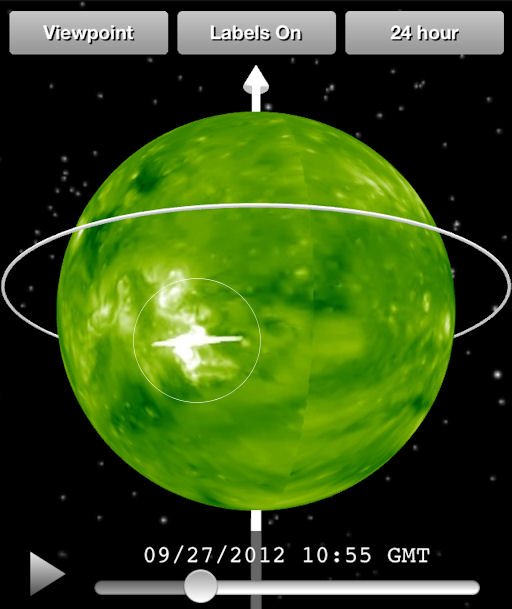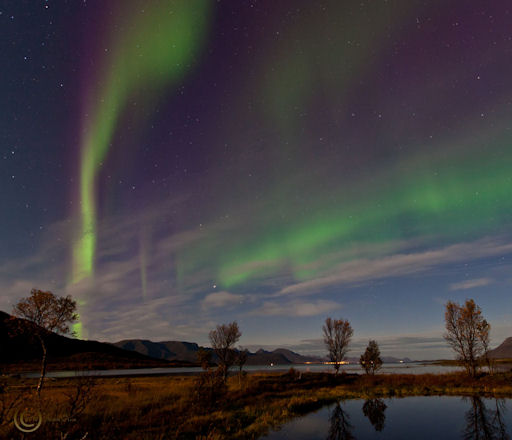HARVEST MOON: This weekend's full Moon is the Harvest Moon, the full Moon closest to the atumnal equinox. Before electric lights, farmers working after sunset relied on the light of the Harvest Moon to help them gather ripening autumn crops. Now it's just a pretty sight. Look east for the Harvest moonrise on Saturday night.
FARSIDE EXPLOSION: A sunspot on the farside of the sun exploded on Sept. 27th, sparking a bright flare of extreme ultraviolet radiation and hurling a massive CME into space. Although the explosion occurred on the other side of the sun, it was visible on cell phones around Earth. Here is a screenshot from NASA's 3D Sun app:
The 3D Sun is a great way to monitor events on the farside of the sun. It displays a realtime globe, which you can pinch, zoom and spin to examine explosions around the complete circumference of the star. Extreme UV images from NASA's twin STEREO probes and the Solar Dynamics Observatory (SDO) are combined to assemble the 360o view, now available on iPhones, iPads, and Android devices.
The active region could flare again. Download the app to track the blast site as it transits the farside en route to the Earthside late next week. Stay tuned for action. Solar flare alerts: text, voice.
POLAR LIGHTS: A medium-speed (~400 km/s) solar wind stream is brushing against Earth's magnetic field, sparking intermittent auroras around the Arctic Circle. Frank Olsen photographed these colorful streamers over Sortland, Norway, during the early hours of Sept. 27th:
"The auroras shone right through the bright moonlight," says Olsen. "It was a nice [little outburst]."
The display was not caused by a geomagnetic storm, but at this time of year no storm is required. For reasons researchers do not fully understand, equixoxes favor auroras. During the nights of early autumn, even a gentle gust of solar wind can ignite colorful lights at high-latitudes. Browse the gallery for current images:

![]()
Solar wind
speed: 352.9 km/sec
density: 0.1 protons/cm3
explanation | more data
Updated: Today at 1452 UT
![]()
X-ray Solar Flares
6-hr max: B5 1322 UT Sep28
24-hr: C3 0000 UT Sep28
explanation | more data
Updated: Today at: 1459 UT
![]()
![]()
![]()
Daily Sun: 28 Sep 12
![]()
![]()
None of these sunspots is actively flaring. Credit: SDO/HMI
![]()
![]()
![]()
Sunspot number: 97
What is the sunspot number?
Updated 28 Sep 2012
Spotless Days
Current Stretch: 0 days
2012 total: 0 days (0%)
2011 total: 2 days (<1%)
2010 total: 51 days (14%)
2009 total: 260 days (71%)
Since 2004: 821 days
Typical Solar Min: 486 days
Update 28 Sep 2012
The Radio Sun
10.7 cm flux: 133 sfu
explanation | more data
Updated 28 Sep 2012
![]()
![]()
![]()
Current Auroral Oval:
![]()
Switch to: Europe, USA, New Zealand, Antarctica
Credit: NOAA/POES
![]()
![]()
![]()
Planetary K-index
Now: Kp= 1 quiet
24-hr max: Kp= 1 quiet
explanation | more data
![]()
Interplanetary Mag. Field
Btotal: 3.4 nT
Bz: 2.1 nT north
explanation | more data
Updated: Today at 1517 UT
![]()
![]()
![]()
Coronal Holes: 28 Sep 12
![]()
![]()
There are no large coronal holes on the Earth side of the sun. Credit: SDO/AIA.






